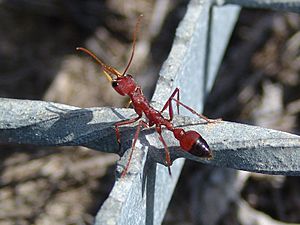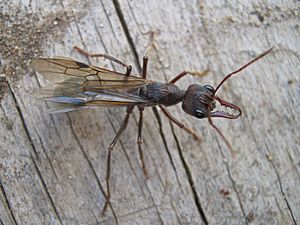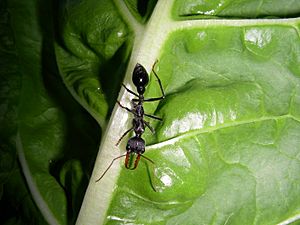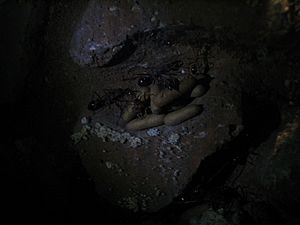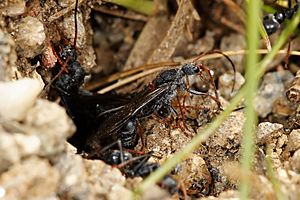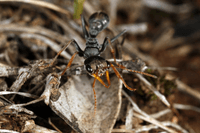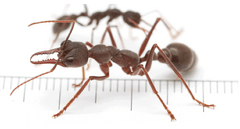Bull ant facts for kids
Quick facts for kids Bull ant |
|
|---|---|
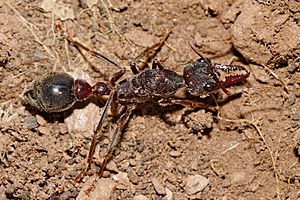 |
|
| Bull ant queen in Swifts Creek, Victoria | |
| Scientific classification |
|
| Unrecognized taxon (fix): | Myrmecia (ant) |
| Type species | |
| Formica gulosa, now Myrmecia gulosa |
|
| Diversity | |
| c. 93 species | |
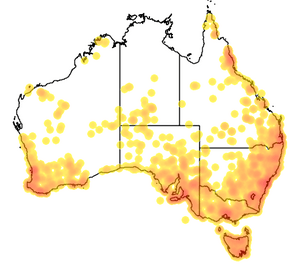 |
|
| Occurrences reported to the Atlas of Living Australia as of May 2015 | |
| Synonyms | |
|
Halmamyrmecia Wheeler, 1922 |
|
Imagine an ant that can jump, has excellent eyesight, and a powerful sting! These are the amazing Myrmecia ants, also known as bull ants, bulldog ants, or jack jumper ants. They are a special group of ants found mostly in Australia and its nearby islands. There are at least 93 different kinds of Myrmecia ants. One species was even found in New Caledonia.
These ants are famous for being very brave and sometimes aggressive. They have long, strong jaws called mandibles and big eyes that help them see very well. They come in many colors and sizes, from about 8 millimeters to 40 millimeters long. That's like the length of a small button to a large paperclip!
Myrmecia ants build their homes mostly in the soil, but you can also find them in old wood or under rocks. One type even lives in trees! A queen ant starts a new colony and hunts for food until her first babies grow up. These ants live longer than many other ants.
Adult bull ants enjoy sweet things like nectar, but their babies (larvae) are meat-eaters. They eat insects that the adult ants catch. Not many animals try to eat bull ants because of their strong sting. However, blindsnakes and echidnas sometimes eat their larvae. Some Myrmecia ants even help pollinate flowers, which is important for plants!
Their stings are very strong, and their venom is one of the most powerful in the insect world. For a small number of people, especially in Tasmania, a sting from a Myrmecia ant (like the jack jumper ant) can cause a very serious allergic reaction. Luckily, doctors can help people who are allergic with special treatments.
Contents
How Bull Ants Got Their Names
The name Myrmecia comes from an Ancient Greek word that means "ant." In Western Australia, some Indigenous Australians called these ants kallili or killal.
These ants have many common names! People often call them bulldog ants, bull ants, or jack jumper ants. This is because they are very brave and can hold onto things tightly with their jaws. Some kinds of Myrmecia ants can even jump when they are upset! Other names you might hear are "inch ants," "sergeant ants," and "soldier ants." The jack jumper ant and its relatives are also known as "black jumpers," "hopper ants," or "jumping jacks."
The History of Bull Ants
Scientists believe that Myrmecia ants have been around for a very long time, possibly over 70 million years! This makes them one of the oldest types of ants on Earth. They are part of a larger group of ants called Myrmeciinae.
Discovering Bull Ants
The first time a Myrmecia ant was officially described was in 1770. A scientist named Joseph Banks found a Myrmecia gulosa ant during his trip with James Cook on the ship HMS Endeavour. This was one of the first Australian insects ever described! Later, in 1804, a Danish zoologist named Johan Christian Fabricius officially named the group Myrmecia.
How Scientists Group Bull Ants
Scientists like to group animals to understand them better. Today, Myrmecia is the only living group in its special tribe, Myrmeciini. There are currently 94 known species, but there might be as many as 130!
Scientists also study the chromosomes of these ants. Some Myrmecia species have a very small number of chromosomes, even just one pair! This is quite unique in the animal world.
Bull Ant Species Groups
Myrmecia ants are divided into nine main groups. These groups help scientists understand the different types of bull ants. Here are some examples:
| Group name | Common name | Example image | Description | Members |
|---|---|---|---|---|
| M. aberrans species group | Wide-jawed bull ants |  |
These are medium to large ants with short jaws and legs. They live in southeastern Australia and have small colonies. | M. aberrans and others. |
| M. cephalotes species group | (No common name) |  |
These ants have bright colors and black heads. They are medium-sized and live in eastern and western Australia. | M. callima and others. |
| M. gulosa species group | Giant bull ants | 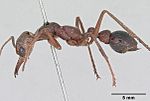 |
These are large, slender ants with long legs. They are common across most of Australia. | M. gulosa and many others. |
| M. mandibularis species group | Toothless bull ants |  |
Medium-sized ants with unique jaw shapes. They live in eastern Australia and Tasmania. | M. fulviculis and others. |
| M. nigrocincta species group | (No common name) |  |
Medium-sized ants with slender bodies and long legs, found in eastern Australia. | M. flammicollis and others. |
| M. picta species group | (No common name) |  |
Small ants found in southern Australia. This is the smallest group with only two members. | M. fucosa and M. picta. |
| M. pilosula species group | Jack jumper ants |  |
Most of these ants are small, with varied colors. They are found across Australia and Tasmania. One species lives in New Caledonia. | M. apicalis and many others. |
| M. tepperi species group | Buck-toothed bull ants |  |
Small or medium-sized ants, similar to the M. pilosula group. They are found in southern Australia. | M. acuta and others. |
| M. urens species group | Baby bull ants | 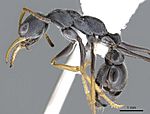 |
All members of this group are small, with varied colors. Most are from coastal Australia. | M. dichospila and others. |
What Do Bull Ants Look Like?
Bull ants are easy to spot because of their big jaws and large compound eyes. These eyes give them amazing vision, which is rare for ants! Each eye has about 3,000 tiny lenses, making them some of the best-seeing ants in the world.
They come in many sizes, from about 8 mm to 40 mm long. The M. brevinoda species has some of the largest workers, reaching up to 37 mm! Their colors vary too, often a mix of black, red, and yellow. Some even have golden hairs. Bright colors can be a warning sign to other animals to stay away.
Worker ants usually look similar in size within a species. However, in some species, workers can be quite different in size. Larger workers often go out to find food or guard the nest. Smaller workers usually stay inside to care for the young. Worker ants have long jaws with several teeth. Their antennae have 12 parts, and they also have three small simple eyes called ocelli.
Queen ants are usually bigger than workers but look similar in color and shape. What's interesting is that some Myrmecia queens have full wings, some have small, undeveloped wings, and others have no wings at all! Male bull ants are easier to tell apart. They have smaller, wider jaws and 13-part antennae that are almost as long as their bodies.
The baby bull ants, called larvae, can grow quite large, up to 35 mm long. Before they become adult ants, they turn into pupae inside dark cocoons.
Where Do Bull Ants Live?
Almost all Myrmecia ants live in Australia and its islands. One species, M. apicalis, is found only on the Isle of Pines in New Caledonia. M. brevinoda ants were once found in New Zealand in 1940, likely brought there by accident, but they haven't been seen there since 1981.
These ants like many different places, including grasslands, forests, and even city areas. You can find their nests in various spots: in the soil, under rocks, in decaying tree stumps or logs, and in sandy areas. Most bull ants build their nests underground. However, one special species, M. mjobergi, builds its nests in trees, often on ferns!
When a queen starts a new colony, her first nest is usually simple. As the colony grows, the nest becomes bigger and more complex. Some nests are dome-shaped mounds with one entrance, while others have many holes and can go several meters deep underground. These mounds can sometimes be as tall as 0.5 meters (20 inches)! Workers often decorate their nests with things like leaves, pebbles, and twigs. They might even use dry materials to help warm the nest with solar energy.
Bull Ant Behavior and Daily Life
Hunting for Food
Myrmecia ants are very old types of ants, and they hunt in a special way. Unlike many other ants, they are often solitary hunters. This means they don't leave scent trails for other ants to follow to food. They also don't usually call other ants to help them find food.
Most bull ants are active during the day, searching for food on the ground or on plants. However, some species are night owls and only hunt after dark! Most are busy during warm months and rest during winter. But one species, M. pyriformis, is active all year round, even at night.
When a bull ant is looking for food, it uses landmarks to find its way back home. If it gets lost, it will look around quickly and then head straight back to its nest. Some bull ants, like M. vindex, even carry their dead friends out of the nest to a special "trash pile."
Helping Plants Grow
While it's not common for ants to pollinate flowers, some Myrmecia species do! For example, a special orchid can only be pollinated by the winged male M. urens ant. The flower actually looks like a female M. urens ant to trick the males into visiting it! M. nigrocincta workers have also been seen visiting Eucalyptus flowers, helping to spread pollen.
What Bull Ants Eat
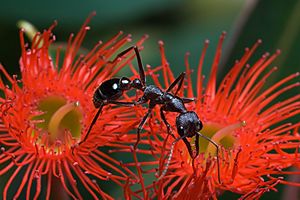
Adult bull ants mostly eat sweet things. They love nectar from flowers and honeydew, which is a sweet liquid left by other insects on leaves. But their babies, the larvae, are meat-eaters! Adult ants catch and kill insects like beetles, caterpillars, and spiders to feed their young. They also share food with each other.
Bull ants are known to hunt other insects like bees, wasps, and even other ants. They also collect things like earthworms, grass seeds, and sometimes even animal droppings for food.
Interestingly, worker bull ants can lay special eggs that are not fertilized. These "trophic eggs" are used as food for the queen and the larvae. This helps make sure the colony has enough to eat.
Who Eats Bull Ants?
Bull ants have a powerful sting, which keeps most predators away. However, some animals do eat them. The blindsnake Ramphotyphlops nigrescens eats the larvae and pupae, carefully avoiding the adult ants' stings. The short-beaked echidna also enjoys a meal of bull ant eggs and larvae.
Some other insects, like certain wasps and parasites, can also affect bull ants. For example, a parasite can change the color of M. pilosula ants from black to brown! Some Myrmecia species are also known to live with other ants or even take over other ant colonies. Other creatures like beetles, skinks, and frogs have been found living peacefully inside bull ant nests.
The Bull Ant Life Cycle
Like all ants, bull ants start as tiny eggs. If an egg is fertilized, it becomes a female (a worker or a queen). If it's not fertilized, it becomes a male. They go through a process called complete metamorphosis, changing from an egg to a larva, then a pupa, and finally an adult ant.
When a new colony starts, several queens might work together to find a good spot. But usually, once the first workers are born, they fight until only one queen remains. A queen will dig a small chamber for her young and hunts for food herself until her first workers are grown. It can take several months for the eggs to become adult ants. Bull ants live longer than many other ants. Some workers can live for over two years! If a colony loses its workers, the queen can start laying eggs again to rebuild her workforce.
How Bull Ants Reproduce
Winged virgin queens and males, called alates, appear in colonies, usually before their special mating flight. This mating flight happens at different times for different species, often from mid-summer to autumn. They prefer hot, stormy days with some wind.
During the mating flight, queens release a special scent that attracts males. Many alates gather to mate. Queens can mate with one or several males. After mating, queens can either start a new colony on their own or sometimes join an existing colony.
Worker ants can also lay eggs, but these eggs are not fertilized and only hatch into male ants. In some cases, if a colony loses its queen, special female workers called gamergates can mate with males and produce new female workers, keeping the colony going!
Super Sight of Bull Ants
Most ants have poor eyesight, but Myrmecia ants have amazing vision! They use their sight to navigate and find food. They can even tell how far away and how big objects are from almost a meter away.
Different ants in a colony have slightly different eye structures depending on their jobs. Ants that are active at night have larger eye parts to help them see in the dark. Bull ants can also see UV light, which means they see colors that humans cannot! Their vision is even better than some mammals, like cats or dogs.
The Powerful Bull Ant Sting
Both worker and queen bull ants have a sting that causes sharp pain. The pain can last for several minutes. Unlike honeybees, bull ants can sting many times because their stinger doesn't have barbs and stays attached to them.
Their retractable stinger is located in their abdomen and is connected to a venom gland. This gland produces the powerful venom they inject into their victims. Larger bull ants often have longer and very potent stingers, with some stings measuring up to 6 mm!
Living with Bull Ants
Bull ants are very well-known ants. They usually only act aggressively when their nest is disturbed. If you bother their home, many workers will quickly rush out to attack. Some species, especially the jack jumper ants, can even jump several inches when they are upset! They use their middle and back legs to push themselves into the air.
One species, M. pyriformis, is even considered one of the most dangerous ants in the world by the Guinness World Records. It's important to remember that most bull ant species are not dangerous to humans unless you are allergic.
Understanding Bull Ant Venom
Each type of Myrmecia ant has slightly different venom. Their venom is among the most powerful in the insect world. In Tasmania, about 2-3% of people are allergic to the venom of the jack jumper ant (M. pilosula). This is a higher percentage than for honeybee or European wasp stings.
For people who are allergic, a bull ant sting can cause a very serious reaction called anaphylaxis. This is why it's important for people with allergies to be careful around these ants. Dogs can also get very sick from many stings.
Treating a Bull Ant Sting
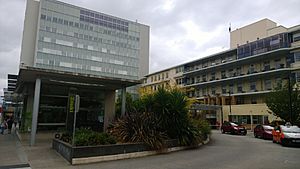
If you get stung by a bull ant, the treatment depends on how serious the reaction is. For mild pain, antihistamine tablets can help. Some Indigenous Australians use traditional plant remedies, like rubbing fern tips or juices from certain plants, to relieve the pain.
Emergency treatment is needed if someone shows signs of a serious allergic reaction. If this happens, the person should lie down with their legs raised, and medical help should be called immediately. People who know they are at risk of anaphylaxis often carry an EpiPen or Anapen. These devices inject adrenaline to help stop a severe reaction.
For people with serious allergies to M. pilosula stings, a special treatment called allergy immunotherapy (or desensitization) is available. This treatment involves giving small, increasing doses of venom over time. This helps the body's immune system learn not to overreact to the venom. This program has been very effective in preventing serious allergic reactions.
How to Avoid Bull Ant Stings
It can be hard to avoid bull ants because they live in many places. The best way to prevent stings is to stay away from their nests. If you see a nest, don't disturb it! Wearing closed shoes or boots can also help, though these ants can sometimes sting through fabric. Be extra careful when gardening, as many stings happen when people don't realize ants are nearby.
Special Uses and Cultural Facts
Because of their strong, large jaws, Myrmecia ants have been used in a very unusual way! In some places, their jaws were used like surgical sutures to help close small wounds.
The M. gulosa ant is the symbol for the Australian Entomological Society. Bull ants have also appeared on postage stamps and special coins in Australia.
The philosopher Arthur Schopenhauer once wrote about bull ants, using them as an example of how life can be a constant struggle. An Australian poet, Diane Fahey, also wrote a poem inspired by his description. A German composer, Karola Obermüller, even named a piece of music after these fascinating ants!
See also




